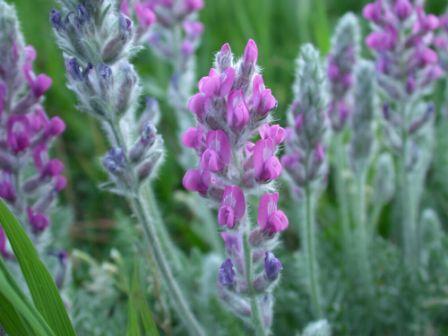 1. Bracken Fern
1. Bracken Fern
Looks Like: A fern with triangular leaves often
found in woody and moist areas.
Where it's found: Everywhere but the Southwest.
What it does: Inhibits the body's ability to process and absorb Vitamin B1. This, over time, leads to
neurological impairment. It is not instantly fatal, but some horses develop a taste for it and will seek it
out.
Symptoms: Neurological dysfunction, depression, lack of coordination, and blindness.
2. Hemlock
Looks Like: Fern like leaves with small white
flowers
Where it's found: Everywhere
What it does: Hemlock contains neurotoxins that are deadly to everyone. These toxins disrupt both the
peripheral and central nervous systems and ingestion is fatal.
Symptoms: Nervousness, tremors, lack of coordination, depression, diminished heart and respiratory rates, colic
and then respiratory failure.
3.Tansy Ragwort:
Looks Like: Looks like small yellow
daisies.
Where It's Found: Everywhere
What it does: Inhibits cell division, especially in the liver.
Symptoms: There are rarely symptoms before liver failure and it cannot be treated. The best defense is to
remove any Tansy Ragwort you find on your property.
4. Sudan Grass/ Johnson Grass
Looks Like: Coarse stemmed
grass with broad leaves that can grow six feet in height. Has large, multi-branched seed heads.
Where it's found: Prevalent in southern climates
What it does: It contains a cyanide compound which inhibits the body's ability to process oxygen.
Symptoms: Rapid breathing, tremors, frequent urination and defecation, gasping and convulsions.
5. Locoweed
Looks Like: Leafy bushes that grow from a
central point, some with silvery hairs, has purple or white blossoms on leafless stalks.
Where it's found: Found in sandy soil throughout the west and southwest.
What it does: Contains a toxin that disrupts the processing of sugars that then build up and disrupt brain cell
function.
Symptoms: Strange behavior, head bobbing, high stepping, staggering, or falling over.
6. Oleander
Looks like: Green all year with thick leaves
that can grow to be ten inches long. The flowers grow in large clusters and are pink, white or red.
Where it's found: A warm weather plant, it grows predominantly in the southern states from Florida to
California.
What it does: Oleander contains the toxins oleandrin and nerin. These toxins disrupt the beating of the heart
and can be fatal.
Symptoms: Colic, difficulty breathing, tremors, recumbency, irregular heart rate and abnormal pulse.
7. Red Maple
Looks like: Leaves are green during the
spring and summer with bright red stems and a white underside. They turn red in the fall. The bark of the tree
is smooth and light grey in young trees, darkening and breaking in older trees.
Where it's found: Mostly on the East Coast
What it does: Breaks down red blood cells so they are unable to carry oxygen to vital organs.
Symptoms: Lethargy, lack of appetite, dark urine, discolored gums and membranes, rapid heart rate and
respiration, dehydration
8. Water Hemlock
Looks like: Water Hemlock looks
shockingly similar to Queen Anne's Lace. Both have bunches of small with blossoms in an umbrella shape.
If you are unsure call to have it removed as Hemlock is an incredibly dangerous plant for all animals- even
humans.
Where it's found: It can be found anywhere there is water or marshlike land.
What it does: The entire plant, considered one of the most toxic in the United States, contains a cicutoxin
alkaloid that destroys the central nervous system.
Symptoms: Drooling, dilated pupils, nervousness, difficulty breathing, seizures, convulsions, death.
9. Yellow Star Thistle/ Russian Knapweed/ Barnaby's
Thistle
Looks Like: Very similar to the dandylion weed, but with long, thin spines that stick out
and prick.
Where it's found: From Missouri to California and up from Mexico to Canada
What it does: It contains a toxin that affects the brain and prevents nerve communication and chewing. It is
not instantly fatal, but constant eating of the weed can prove fatal is consumption is high and continuous.
Symptoms: Clenched or tense facial muscles, weight loss, inability to bite or chew properly
10. Yew
Looks like: An evergreen looking bush with bright
red berries that end in a darker "eye"
Where it's found: Common ornamental, found all over
What it does: Taxine can be found in all parts of the yew plant with the exception of the berries. Taxine is an
alkaloid that causes respiratory and cardiac collapse and the leaves will remain toxic even after being dried
and a mouthful can kill a horse within minutes. Avoidance is the best way to help keep your horse safe.
Symptoms: Sudden death, trembling and colic, difficulty breathing, slow heart rate
Related Articles
Breaking a Leg- What It Means For Your
Horse
Deadly Equine Diseases
Tips for Keeping Flies Under
Control
Horse Inspection Checklist
Five Most Common Horse Diseases
How to Spot a Malnourished Horse
Top 10 Most Poisonous Plants for Horses
Feeding and Rebuilding a Malnourished
Horse
Helping a Horse Living with Cushing's
How to Treat Abscesses on Your Horse
Colic and Your Horse
Confirming That Your Horse Has Rabies
Helping a Pregnant Mare
Handling a Rattlesnake Bite to Your Horse
Being Aware of Tetanus and Your Horse
Preventing Thrush in Your Horse